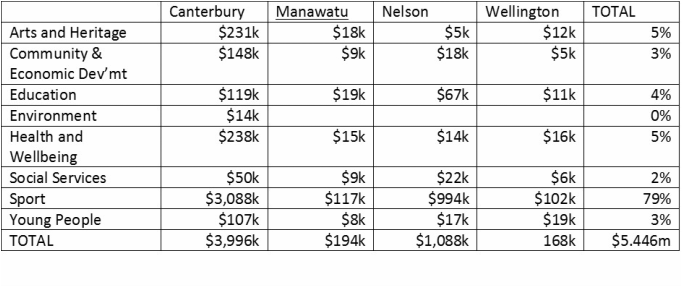
The last blog I did on a funder got a few comments, so I thought I’d have a crack at another. It’s also good timing, given the recent announcement of a review of the future of pokies.
This week its Mainland Foundation’s 2015 grants, from 1 August 2014 – 31 July 2015.
Now it’s interesting to look at the authorised purposes that the funder applies their gaming monies to. There are five main elements:
- Amateur South Island rugby north of the Waitaki River, including the West Coast
- Amateur sport
- Charitable purposes for the relief of poverty
- Cultural grants beneficial for the community
- Grants for education of training
Funding decisions in 2015 by province are set out below. As expected, Sport receives 79% of funding.
So I have broken this down so I can see what sorts of money goes into which code. Given authorised purpose one, it’s not surprising to see that $2.8m goes towards rugby in Canterbury and Nelson. Interestingly, we can break this down further.
In 2015 Canterbury Rugby Football Union Inc. received just over $2m from the Mainland Foundation. Tasman Rugby Union received just over $400k, Manawatu Rugby Union Inc. received just over $40k, with the balance of the monies going to clubs throughout the gaming trust’s catchment.
Now, I had a look through the 2015 books for Canterbury Rugby Football Union on the Societies website, and am ever so slightly confused. In their accounts they declared almost $1.8m in 2015 from donations - $200k less than Mainland said they gave them. Of course this could be timing (balance date 31 Oct, whereas the Mainland date is 31 July). CRFU also returned $20k in donations. The other issue where we have to rely on trust is around the purpose of those funds: remember that the purpose of Mainland Foundation is to support AMATEUR rugby. The CRFU’s accounts make it difficult to ensure that those donations are for amateur rugby: I am sure they are, but I do think that there needs to be a bit more transparency around this.
Looking at declines was interesting too: although it’s not disclosed why applications are declined, it was heartening to see a full mix of sports clubs as well as other organisations in the decline bucket.
Now, rugby is allowed to apply for funds, and indeed the union has set up Mainland Foundation to support themselves. But to me it raises a couple of questions:
- Why do the good folks of Palmie want to support South Island rugby?
- Is this something the community sees as important?
- Why do other trusts support rugby at all? Looking at my data CRFU specifically received funds from Air Rescue, CERT and Rata Foundation. And if I look at my data for 2014, Mainland Foundation provided just 53% of funding for Canterbury rugby.
- Organisations always want more. How much is too much? What is the “right” level of grant support for sport vs self generated and subs? I could be wrong but I could not see any form of user pays from players headed to CRFU. Mainland Football, by contrast, generates around 25% of its income from players.
- How does the organisation ensure that the grants go to amateur sports rather than professional? How does it ensure public accountability around this?
- How are decisions made? Mainland Foundation seems to have three decision makers: one the CE, and two other men. The only female listed on the website is the Office Administrator. This demographic skew exists in the other gaming trust I looked at a month ago, CERT, who has four men who are both the officers and on the net proceeds committee.Just a thought: Not for Profit organisations are skewed towards female employees, with some US research finding 75% of the NFP workforce as female.Yet the female voice has not been reflected in the two groups I have looked at, who together put $7.4m into the community last year.
I do this analysis as I personally believe we have a very inefficient market for funding dollars, and no one else seems to be looking at this. I believe that sunlight will restore a bit of equity and perhaps get financial support to organisations who make life better for people. Would love to talk with you if you think this is just a little bit interesting.
 RSS Feed
RSS Feed